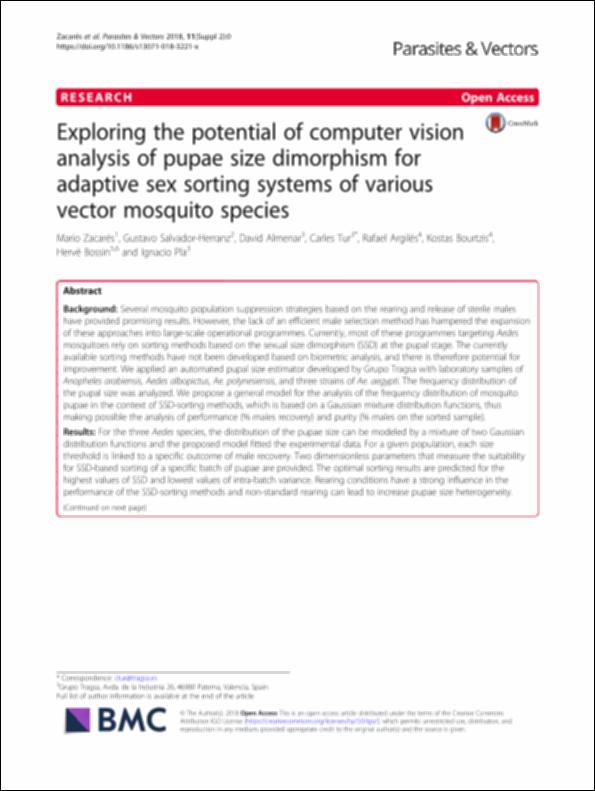Por favor, use este identificador para citar o enlazar este ítem:
http://hdl.handle.net/10637/10249Exploring the potential of computer vision analysis of pupae size dimorphism for adaptive sex sorting systems of various vector mosquito species
| Título : | Exploring the potential of computer vision analysis of pupae size dimorphism for adaptive sex sorting systems of various vector mosquito species |
| Autor : | Zacarés González, Mario Salvador Herranz, Gustavo Almenar Gil, David Tur Lahiguera, Carles Argilés Herrero, Rafael Bourtzis, Kostas Bossin, Hervé Plá Mora, Ignacio |
| Materias: | Culícidos - Genética - Control.; Biometría.; Biometry.; Esterilidad.; Infertility.; Insects as carriers of disease - Genetics - Control.; Genética de poblaciones - Modelos matemáticos.; Population genetics - Mathematical models.; Insectos vectores - Genética - Control.; Mosquitoes - Genetics - Control. |
| Editorial : | Springer Nature. |
| Citación : | Zacarés, M., Salvador Herranz, G., Almenar, D., Tur, C., Argiles, R., Bourtzis, K. et al. (2018). Exploring the potential of computer vision analysis of pupae size dimorphism for adaptive sex sorting systems of various vector mosquito species. Parasites and Vectors, vol. 11, supl. 2, art. 656. DOI: https://doi.org/10.1186/s13071-018-3221-x |
| Resumen : | Background: Several mosquito population suppression strategies based on the rearing and release of sterile males have provided promising results. However, the lack of an efficient male selection method has hampered the expansion of these approaches into large-scale operational programmes. Currently, most of these programmes targeting Aedes mosquitoes rely on sorting methods based on the sexual size dimorphism (SSD) at the pupal stage. The currently available sorting methods have not been developed based on biometric analysis, and there is therefore potential for improvement. We applied an automated pupal size estimator developed by Grupo Tragsa with laboratory samples of Anopheles arabiensis, Aedes albopictus, Ae. polynesiensis, and three strains of Ae. aegypti. The frequency distribution of the pupal size was analyzed. We propose a general model for the analysis of the frequency distribution of mosquito pupae in the context of SSD-sorting methods, which is based on a Gaussian mixture distribution functions, thus making possible the analysis of performance (% males recovery) and purity (% males on the sorted sample). Results: For the three Aedes species, the distribution of the pupae size can be modeled by a mixture of two Gaussian distribution functions and the proposed model fitted the experimental data. For a given population, each size threshold is linked to a specific outcome of male recovery. Two dimensionless parameters that measure the suitability for SSD-based sorting of a specific batch of pupae are provided. The optimal sorting results are predicted for the highest values of SSD and lowest values of intra-batch variance. Rearing conditions have a strong influence in the performance of the SSD-sorting methods and non-standard rearing can lead to increase pupae size heterogeneity. Conclusions: Sex sorting of pupae based on size dimorphism can be achieved with a high performance (% males recovery) and a reasonably high purity (% males on the sorted sample) for the different Aedes species and strains. The purity and performance of a sex sorting operation in the tested Aedes species are linked parameters whose relation can be modeled. The conclusions of this analysis are applicable to all the existing SSD-sorting methods. The efficiency of the SSDsorting methods can be improved by reducing the heterogeneity of pupae size within rearing containers. The heterogeneity between batches does not strongly affect the quality of the sex sorting, as long as a specific separation threshold is not pre-set before the sorting process. For new developments, we recommend using adaptive and precise threshold selection methods applied individually to each batch or to a mix of batches. Adaptive and precise thresholds will allow the sex-sorting of mixed batches in operational conditions maintaining the target purity at the cost of a reduction in performance. We also recommend a strategy whereby an acceptable level of purity is pre-selected and remains constant across the different batches of pupae while the performance varies from batch to batch to fit with the desired purity. |
| Descripción : | Este artículo se encuentra disponible en la página web de la revista en la siguiente URL: https://parasitesandvectors.biomedcentral.com/articles/10.1186/s13071-018-3221-x |
| URI : | http://hdl.handle.net/10637/10249 |
| Derechos: | http://creativecommons.org/licenses/by/4.0/deed.es |
| ISSN : | 1756-3305. |
| Fecha de publicación : | 24-dic-2018 |
| Centro : | Universidad Cardenal Herrera-CEU |
| Aparece en las colecciones: | Dpto. Proyectos, Teoría y Técnica del Diseño y la Arquitectura |
Los ítems de DSpace están protegidos por copyright, con todos los derechos reservados, a menos que se indique lo contrario.


